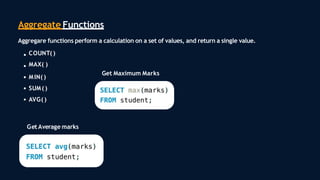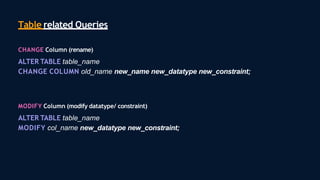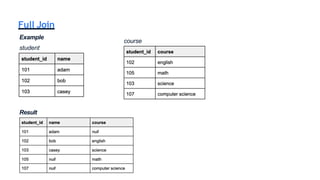DBMS and SQL(structured query language) .pptx
- 1. Database Database is collection of data in a format that can be easily accessed (Digital) A software application used to manage our DB is called DBMS (Database Management System)
- 2. Types of Databases Relational Data stored in tables Non-relational (NoSQL) data not stored in tables ** We use SQL to work with relational DBMS
- 3. What is SQL? Structured Query Language SQL is a programming language used to interact with relational databases. It is used to perform CRUD operations : Create Read Update Delete
- 5. What is a table? Student table
- 6. CREATE DATABASE db_name; DROP DATABASE db_name; Creating our First Database Our first SQL Query
- 7. Creating our First Table USE db_name; CREATE TABLE table_name ( column_name1 datatype constraint, column_name2 datatype constraint, column_name2 datatype constraint );
- 8. SQL Datatypes They define the type of values that can be stored in a column
- 9. SQL Datatypes Signed & Unsigned TINYINT UNSIGNED (0 to 255) TINYINT (-128 to 127)
- 10. Typesof SQLCommands DDL (Data Definition Language) : create, alter, rename, truncate & drop DQL(Data Query Language) : select DML (Data Manipulation Language) : select, insert, update & delete DCL (Data Control Language) : grant & revoke permission to users TCL (Transaction Control Language) : start transaction, commit, rollback etc.
- 11. Database related Queries SHOW DATABASES; SHOW TABLES; CREATE DATABASE db_name; CREATE DATABASE IF NOT EXISTS db_name; DROP DATABASE db_name; DROP DATABASE IF EXISTS db_name;
- 12. Table related Queries Create CREATE TABLE table_name ( column_name1 datatype constraint, column_name2 datatype constraint, );
- 13. Table related Queries SELECT * FROM table_name; Select & ViewALLcolumns
- 14. Table related Queries Insert INSERT INTO table_name (colname1, colname2); VALUES (col1_v1, col2_v1), (col1_v2, col2_v2);
- 15. Keys Primary Key It is a column (or set of columns) in a table that uniquely identifies each row. (a unique id) There is only 1 PK & it should be NOT null. Foreign Key A foreign key is a column (or set of columns) in a table that refers to the primary key in another table. There can be multiple FKs. FKs can have duplicate & null values.
- 16. Keys table1 - Student table2 - City
- 17. Constraints UNIQUE PRIMARY KEY SQL constraints are used to specify rules for data in a table. NOT NULL columns cannot have a null value all values in column are different makes a column unique & not null but used only for one
- 18. Constraints FOREIGN KEY prevent actions that would destroy links between tables DEFAULT sets the default value of a column
- 19. Constraints CHECK it can limit the values allowed in a column
- 20. Create this sample table Insert this data
- 21. Select in Detail used to select any data from the database Basic Syntax SELECT col1, col2 FROM table_name; To Select ALL SELECT * FROM table_name;
- 22. Where Clause To define some conditions SELECT col1, col2 FROM table_name WHERE conditions;
- 23. Arithmetic Operators : +(addition) , -(subtraction), *(multiplication), /(division), %(modulus) Comparison Operators : = (equal to), != (not equal to), > , >=, <, <= Logical Operators : AND, OR , NOT, IN, BETWEEN, ALL, LIKE, ANY Bitwise Operators: & (Bitwise AND), | (Bitwise OR) Where Clause UsingOperatorsin WHERE
- 24. Operators AND (to check for both conditionsto be true) OR (to check for one of the conditions to be true)
- 25. Between (selects for a given range) In (matches any value in the list) NOT (to negate the given condition) Operators
- 26. Limit Clause Sets an upper limit on number of (tuples)rows to be returned SELECT col1, col2 FROM table_name LIMIT number;
- 27. Order By Clause To sort in ascending (ASC)or descending order (DESC) SELECT col1, col2 FROM table_name ORDER BY col_name(s) ASC;
- 28. Aggregate Functions Aggregare functions perform a calculation on a set of values, and return a single value. COUNT( ) MAX( ) MIN( ) SUM( ) AVG() Get Average marks Get Maximum Marks
- 29. Group By Clause Groups rows that have the same values into summary rows. It collects data from multiple records and groups the result by one or more column. *Generally we use group by with some aggregation function. Count number of students in each city
- 30. HavingClause Similar to Where i.e. applies some condition on rows. Used when we want to apply any condition after grouping. Count number of students in each city where max marks cross 90.
- 31. General Order SELECT column(s) FROM table_name WHERE condition GROUPBY column(s) HAVING condition ORDERBY column(s) ASC;
- 32. HavingClause Similar to Where i.e. applies some condition on rows. Used when we want to apply any condition after grouping. Count number of students in each city where max marks cross 90.
- 33. Table related Queries Update (to update existingrows) UPDATE table_name SET col1 = val1, col2 = val2 WHERE condition;
- 34. Table related Queries Delete (to delete existing rows) DELETE FROM table_name WHERE condition;
- 35. Cascading for FK On Delete Cascade When we create a foreign key using this option, it deletes the referencing rows in the child table when the referenced row is deleted in the parent table which has a primary key. On Update Cascade When we create a foreign key using UPDATE CASCADE the referencing rows are updated in the child table when the referenced row is updated in the parent table which has a primary key.
- 36. Table related Queries Alter (to change the schema) ADD Column ALTER TABLE table_name ADD COLUMN column_name datatype constraint; DROP Column ALTER TABLE table_name DROP COLUMN column_name; RENAME Table ALTER TABLE table_name RENAME TO new_table_name;
- 37. Table related Queries MODIFY Column (modify datatype/ constraint) ALTER TABLE table_name MODIFY col_name new_datatype new_constraint; CHANGE Column (rename) ALTER TABLE table_name CHANGE COLUMN old_name new_name new_datatype new_constraint;
- 38. ADD Column RENAME Table DROP Column MODIFY Column CHANGE Column (rename)
- 39. Table related Queries Truncate (to delete table's data) TRUNCATE TABLE table_name ;
- 40. Joins in SQL Join is used to combine rows from two or more tables, based on a related column between them.
- 41. Types of Joins Inner Join Left Join Right Join Full Join Outer Joins
- 42. Inner Join Returns records that have matching values in both tables Syntax SELECT column(s) FROM tableA INNER JOIN tableB ON tableA.col_name = tableB.col_name;
- 43. Inner Join Example SELECT * FROM student INNER JOIN course ON student.student_id = course.student_id; student course Result
- 44. Left Join Returns all records from the left table, and the matched records from the right table Syntax SELECT column(s) FROM tableA LEFT JOIN tableB ON tableA.col_name = tableB.col_name;
- 45. Left Join Example SELECT * FROM student as s LEFT JOIN course as c ON s.student_id = c.student_id; student course Result
- 46. Right Join Returns all records from the right table, and the matched records from the left table Syntax SELECT column(s) FROM tableA RIGHT JOIN tableB ON tableA.col_name = tableB.col_name;
- 47. Right Join Example SELECT * FROM student as s RIGHT JOIN course as c ON s.student_id = c.student_id; student course Result
- 48. Full Join Returns all records when there is a match in either left or right table Syntax in MySQL LEFT JOIN UNION RIGHT JOIN
- 50. Qs: Write SQL commands to display the right exclusive join : Think & Ans Right Exclusive Join Left Exclusive Join
- 51. Self Join It is a regular join but the table is joined with itself. Syntax SELECT column(s) FROM table as a JOIN table as b ON a.col_name = b.col_name;
- 53. Union It isused to combine the result-set of two or more SELECTstatements. GivesUNIQUE records. Syntax SELECT column(s) FROM tableA UNION SELECT column(s) FROM tableB To use it : every SELECT should have same no. of columns columnsmust have similar data types columns in every SELECT should be in same order
- 54. SQLSub Queries A Subquery or Inner query or a Nested query is a query within another SQL query. Query Sub Query It involves2 select statements. Syntax SELECT column(s) FROM table_name WHERE col_name operator ( subquery );
- 55. SQL Sub Queries Example Get names of all students who scored more than class average. Step 1. Find the avg of class Step 2. Find the names of students with marks > avg
- 56. SQL Sub Queries Example Find the names of all students with even roll numbers. Step 1. Find the even roll numbers Step 2. Find the names of students with even roll no
- 57. SQL Sub Queries Example with FROM Find the max marks from the students of Delhi Step 1. Find the students of Mumbai Step 2. Find their max marks using the sublist in step 1
- 58. MySQL Views A view is a virtual table based on the result-set of an SQL statement. *A view always shows up-to-date data. The database engine recreates the view, every time a user queries it.

























































